THIS POST INCLUDES:
1. Choosing art making for self-care
2. Regular breaks during the day
3. Be aware of your emotional state
4. Free Download Self-care Art Activity
CHOOSING ART MAKING FOR SELF-CARE
Self-care is an essential part of being an Art Therapist or someone in the helping industry. Self-care is physical and psychological care provided by you to you. In our previous post on self-care you can read about developing your self-care plan along with some self-care activities and resources to use.
Your self-care plan should be developed based on the below strategy:
- regular breaks during the day
- regular exercise, healthy eating, restful sleep
- be aware of your emotional state
- regularly assess your self-care plan
In this blog post, we’re going to explore stages 1 and 3 in more detail. Our previous blog post about self-care for the art therapist covered a wide variety of self-care techniques. This blog post will focus specifically on using art activities as a self-care process of taking regular breaks and being aware of your emotional state.
Creating art can be a helpful time of quiet self-reflection for you to express your inner feelings and thoughts. As a therapist, you may feel this activity itself is enough self-care, however, there are many benefits of incorporating your art self-care work with a supervisor, other art therapists, or an online support group.
Connecting with other people for your self-care can enhance your art-making activities by staying motivated and receiving feedback while relying less on internal regulation and willpower. You may want to make this connection occasionally as well as engage in your own art-making activities as a daily activity for self-care.
REGULAR BREAKS DURING THE DAY
BEFORE YOUR SESSION
Check in with your emotions prior to your client sessions. Can you identify the emotion and what it relates to? Is the emotion related to seeing your next client or are you carrying feelings from another situation?
Identifying the source of your emotion can help hone your focus on a specific area as a source of dysfunction instead of carrying the belief that all areas of your life are contributing to any negatively held emotions.
AFTER A DIFFICULT SESSION
After your session has completed, take some time before your next session or tasks to explore your emotional reaction.
MAKE ART
Exercises:
- How do you feel today – using colours, shapes, line and images
- Doodling – doodling can be done in silence or while listening to some music that has some significance for you, eg. Inspirational
- Create an artwork that focuses on a theme of emotional release. For example: release, letting go, freedom, cleanse, fresh start
- Create an art work or coping kit that reminds you of your self-care activities
Doodling Exercise
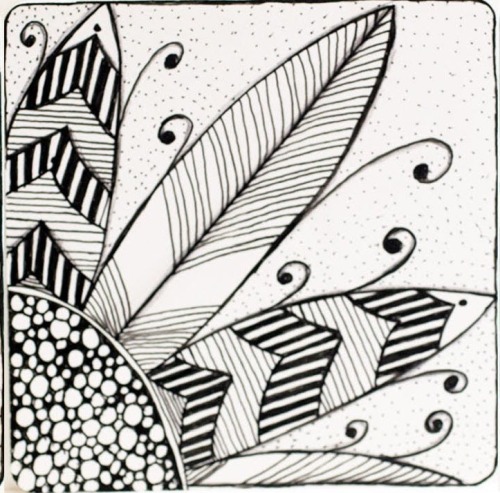
Self-care activities
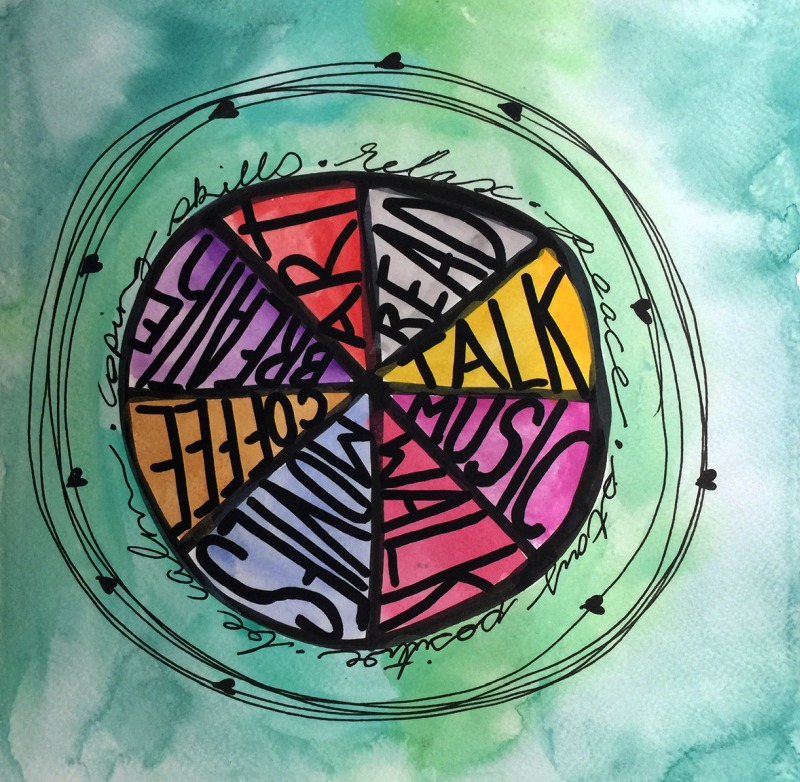

JOURNALING A SESSION
Exercises:
- Ask yourself, How do you feel today? You may be able to freeform your writing or you may prefer to journal to prompts such as:
- What emotion am I feeling now?
- What is frustrating me now?
- What do I feel grateful for now?
- Do a brain dump of pervasive thoughts
END THE DAY
Exercises:
- How do you feel today – using colours, shapes, line, and images
- After your session work is completed for the day, you may have more time for self-care. During this time you can reflect on any smaller activities you did during the day including either artwork or journaling. You can explore some of these art activities in more depth to understand your emotional response to any parts of your day.
You can also use this time of the day as an opportunity to brain-dump any lingering thoughts or emotions from the day. This might relate to a specific event that occurred during the day or it could just relate to an overall feeling of the entire day, eg, tiredness,
BE AWARE OF YOUR EMOTIONAL STATE
It is important to be aware of your own emotional state in therapy-related industries such as art therapy. As you are exposed to sometimes traumatic dynamics of your client’s life, this can eventually begin to affect your emotional well-being. Additionally, you may work with treatment-resistant clients who challenge you.
The below strategies can be implemented as part of your self-care plan to explore your emotional well-being:
- Seek supervision
- Use mindful meditation to explore the body/mind connection for feelings of tension
- Use art therapy to explore the body/mind connection for feelings of tension
- Use art therapy to explore emotions
MAKE ART
You can use the exercises mentioned in the previous section on taking regular breaks during the day as well as the below exercises
Exercises:
- Use art therapy to explore the body/mind connection for feelings of tension. Reflect on the physical feelings you are currently experiencing in your body and create an artwork that represents this feeling in your body. How would you connect this physical feeling to your current emotional well-being? (picture below)
- Create an emotional barometer to help get perspective on how intense an emotion feels at the time of a negative event. Create the same emotional barometer after using coping skills to self-regulate your emotions. (picture below)
Mind/Body Exercise
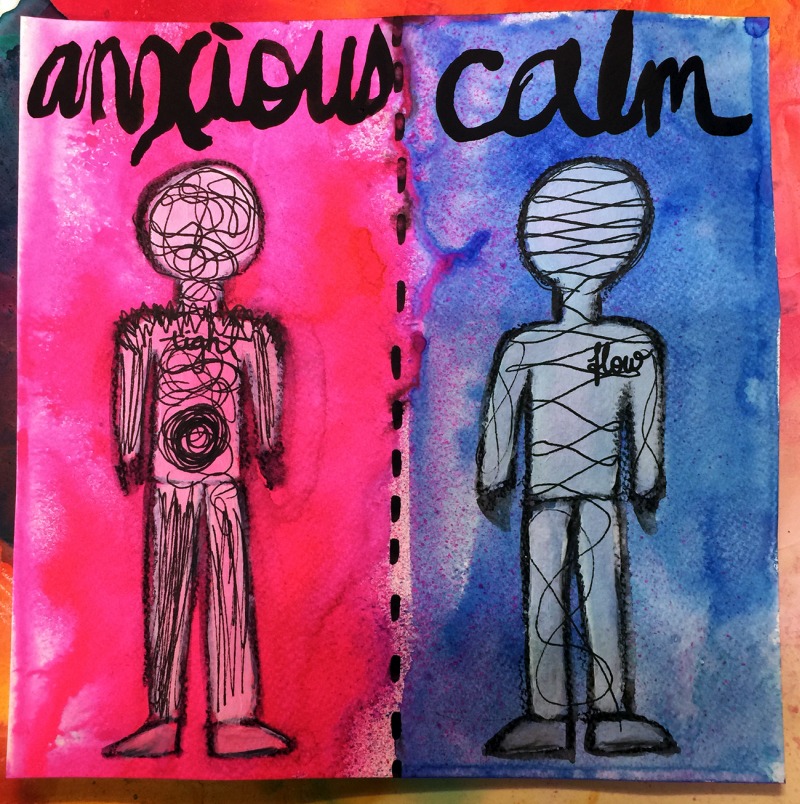
Emotional Barometer Exercise: (taken from Basic Emotions Guidebook)

To explore art therapy and emotions in further detail, we have a Basic Emotions Guidebook available in the store.
The main topics covered include:
- Introduction to emotions
- Psychology of emotions
- Treatment
- Self-regulation
- 20 Art Therapy Exercises
We’ve also created an Emotions board on Pinterest with some useful resources to explore emotions.
Some additional self-care activities that are not based on creating art include:
EMOTIONAL SELF-CARE
- Spend time with family and friends
- Read light-hearted books
- Watch comedy movies
- Engage in activities that provide comfort
- Physically experience emotions through crying and laughing
- Channel anger and frustration through action such as exercise, journaling, protests, petitions etc
- Use mindfulness to meditate on your experience of emotions
- Be mindful of bodily aches and pains that may connect with an emotional experience
- Identify your emotional triggers
- Implement a practice of gratitude
- Be mindful of perceived mistakes and reframe your expectations
- Engage in some art therapy for yourself
The above list of suggested activities may appear overwhelming and if you are currently feeling pressure in other areas of your life, you may view the above list as yet another to-do.
Just pick one simple thing to do. Make your plan for self-care an easy win by choosing an activity with limited barriers. Make the activity short in time and limited in difficulty. Once you have achieved that level of self-care, use that achievement as inspiration to pursue other activities.
We’ve created a Self-care Pinterest board for you to use as inspiration. Save some of your favourite ideas to your Pinterest account, then schedule a reminder into your calendar to pick an activity from your Pinterest board. You can access the Self-care Pinterest board here.
FREE DOWNLOAD: Self-Care Activities Checklist
SIGN UP below to download the FREE Self-care Activities Checklist.
You can also access this Evernote document for a summary checklist of the self-care activities. You can save this note to your own Evernote. You can view the Evernote document even if you do not use Evernote.
Download the Self-care Activities Checklist.
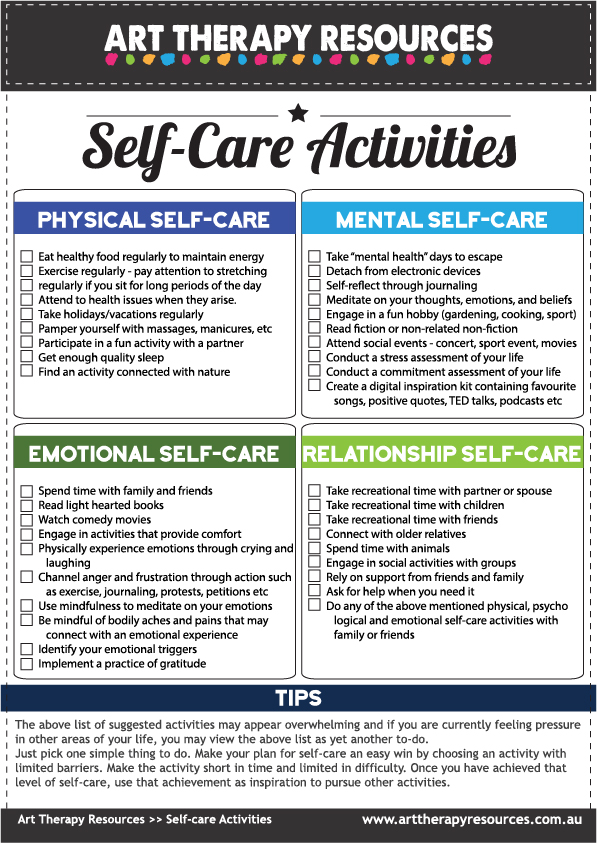
BUILD YOUR ART THERAPY REFERENCE MATERIALS:
Pin this image to your Pinterest board.
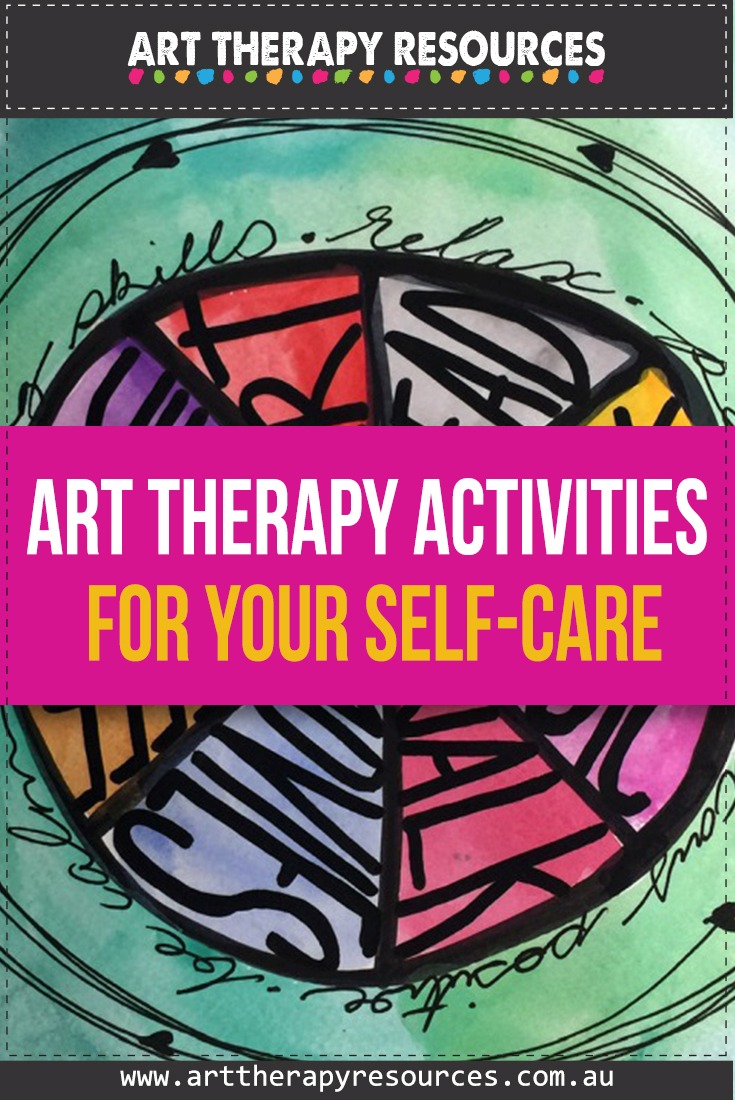
SHARE KNOWLEDGE & PASS IT ON:
If you’ve enjoyed this post, please share it on Facebook, Twitter, Pinterest. Thank you!


